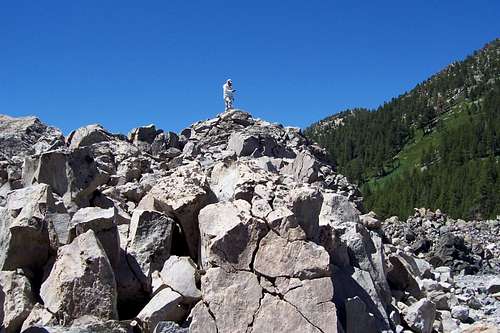dyusem - Sep 11, 2011 10:54 am - Hasn't voted
one clarificationThanks for the write-up!
One clarification: you stated that Obsidian Dome is located in the "Owens Valley of Central California", this is incorrect.
A more apt description of the location would be that it is located in east-central California and is a part of the Mono-Inyo Craters which are roughly parallel to the eastern escarpment of the Sierra Nevada mountain range.
Marcsoltan - Sep 11, 2011 11:30 am - Hasn't voted
Re: one clarificationYou are absolutely right. I was pouring over my maps yesterday to see if Obsidian Dome was part of Owns Valley or not. My maps were inconclusive. In either case, I will change the text to reflect that correction.
Thank you.
dyusem - Sep 11, 2011 11:43 am - Hasn't voted
Visiting in WinterYou're welcome! Also, it is a wonderful area to snowshoe or XC ski during the winter with some great skiing in the trees and over what looks like marshmallows covering the obsidian.
Sierra Ledge Rat - Sep 13, 2011 7:12 am - Voted 10/10
Great placeThe volcanic landforms around the eastern Sierra are under-appreciated, in my opinion. There is a lot of great stuff to see, like the obsidian domes, craters and explosion pits. Bouldering on obsidian presents a serious challenge! Here are a few photos of my own from Panum Crater:
http://www.summitpost.org/summiting-on-obsidian/591561/c-389894
http://www.summitpost.org/bouldering-on-obsidian/591562/c-389894
http://www.summitpost.org/fooling-around-on-obsidian/591564/c-389894
Marcsoltan - Sep 13, 2011 11:05 am - Hasn't voted
Re: Great placeThank you for the photos. I've done the Panum rim hike but next time in the area I'll try to get into the crater.
Buz Groshong - Sep 13, 2011 1:35 pm - Hasn't voted
Greed?The title says "testimony to utility and greed," but there is no explanation. You do talk about mining activity, but you fail to explain what they were mining it for and how this activity is greedy. We have converted a lot of forest and prairie land to farms so that we can eat but we don't call that greedy, so is mining automatically greedy? Please explain.
Marcsoltan - Sep 13, 2011 2:52 pm - Hasn't voted
Re: Greed?It seems that there was sufficient explanation to reach the conclusion that you have reached even though you do not agree with my assessment of the situation. Yes, I consider changing the landscape for commercial use, to the degree that we have, is nothing short of greed. In the case of changing forestlands to grow crops, if we leave the land untouched for a few hundred years, it will recover from that change. The top of Obsidian Dome, unfortunately, will be permanently scarred. In my article, I have expressed only my opinion, and I do not expect everyone to agree with it.
blackhawk - Sep 14, 2011 12:14 pm - Hasn't voted
a lil unclearThanks for a little explanation of what native americans did with obsidian. Im also into the primitive skills and arts(bowyering and flintknapping),and make primitive bows and stone points. I collect natural resources with my own hands and make tools and weapons to hunt with and to feed my family much like man did for thousands of years. So are you just upset with the machine scars from the mining past, or from people who still go there to collect rock to make stone tools?or both? I see no wrong in taking resources from the earth and correctly using them for our needs and survival. Its what they were put here for. Yes i agree the mining scars from the past are ugly,but it was a different time and era back then,and we can't change what happened. .. By the way my avatar pic is a dacite stonepoint...lol.
Marcsoltan - Sep 14, 2011 12:34 pm - Hasn't voted
Re: a lil unclearI have no problem with individuals, such as yourself, collecting and making tools to make a living as Native Americans did for eons of time. I just didn't like to see the impact that heavy machinery and mass exploitation has left behind.
MoapaPk - Sep 15, 2011 10:32 am - Voted 10/10
remember it wellI worked on a scientific drilling platform that punched a small hole (core sample) through the dome, between that and the next dome farther south, and at the end of the chain. I spent a lot of time walking around that and other domes. It surely isn't in pristine shape, but it isn't an Armageddon; you can't even see the one-lane road till you round the bend.
Of interest is White Wing Mountain, which was stripped bare by the violent explosion that preceded the birth of the domes about 600 years ago. White Wing still has a forest of dead trees, killed by the explosion.
It's a neat area, testimony to the recent volcanic activity below the caldera.
As for mass exploitation for profit, try visiting Mammoth Lakes, a short distance away! That is a volcanic mountain, and the ski slopes are not natural, nor are the wide macadam roads that take tourists into the park. Where the city is, was once forest.
Marcsoltan - Sep 15, 2011 11:00 am - Hasn't voted
Re: remember it wellThank you, Harlan. You are putting a lot of information on the table. I'm going to have to visit White Wing Mountain at some point in time.
My main issue was not really the road so much as it was what has happened to the top area of the dome. But, I certainly understand your point about Mammoth Mountain and mass exploitation. The scars left behind from creating those ski runs are an eye sore during the summer months. As it turns out Mammoth is my family's favorite resort for skiing. I guess my selfishness blinded me to those scars. Thanks for putting things more in perspective.
MoapaPk - Sep 15, 2011 12:35 pm - Voted 10/10
Re: remember it wellIt's useful to go to Google Earth and look down on the Dome. You'll be stunned how little of the cow pie plateau is actually disturbed-- far less than 1%, and not near the top. The top is a very nasty jumble of sharp, porous obsidian/pumice blocks (I've been there). Without the narrow roads, travel anywhere on the dome would be extremely difficult.



















Comments
Post a Comment